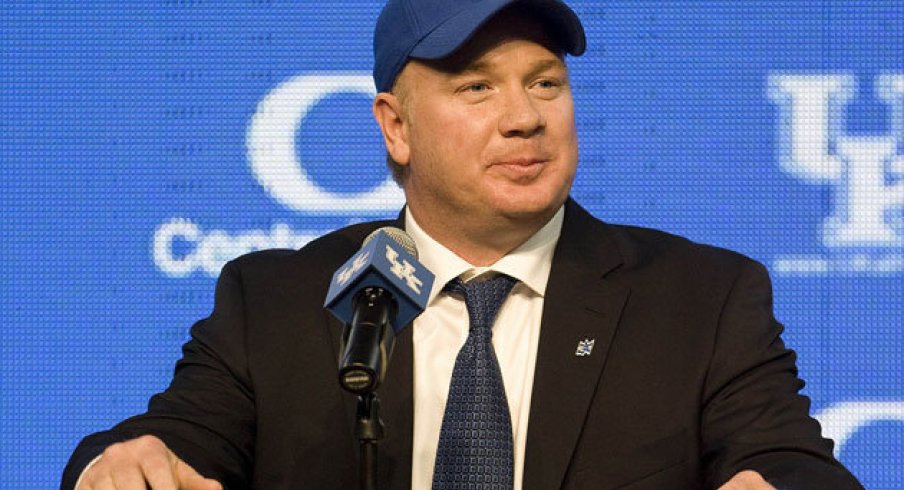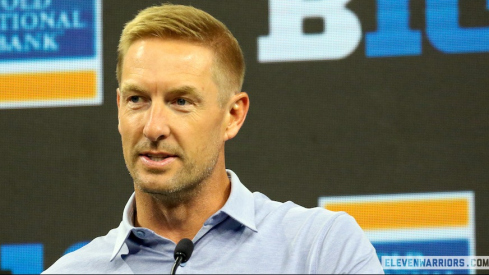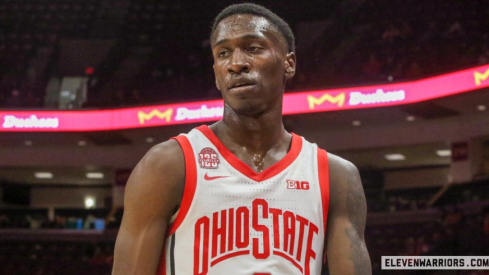Another National Signing Day extravaganza came and went with no shortage of intrigue and causes for celebration.
The clear winners of the day were Alabama and USC. Alabama, notwithstanding very urgent issues of oversigning, took the best from Iowa and Minnesota and signed more five-stars than I thought any class could conceivably see. USC may have made the strongest push on National Signing Day as any team in the country.
In the Big Ten, Michigan State and Ohio State were the day's headline attractions. Though his decision was not without some additional drama, Malik McDowell of Southfield, Michigan, committed to the reigning Big Ten and Rose Bowl champions. Ohio State signed, by far, the conference's best overall class.
It seems every Big Ten program has something for which to celebrate. Michigan boasts the conference's best overall recruit. Minnesota has the best running back commitment in the class. Nebraska and Penn State closed very well down the stretch. Nebraska may have found new life recruiting with the hire of secondary coach Charlton Warren. James Franklin hit the ground running at Penn State, even if most of it came at the expense of Franklin's former employer.
Even Illinois and Purdue, conference cellar-dwellers of late, have reasons to brag. Illinois got a slew of quality, and under the radar, JUCO players like Jihad Ward. It also got Jeff George's son on a grayshirt offer, just in case he turns out useful. Purdue has its ideal prospect of a quarterback on campus already. David Blough was the story of Elite 11 in the summer of 2013 and held firm to his commitment to Darrell Hazell.
These superlatives of each Big Ten recruiting class and more were discussed on BTN during the network's Football Signing Day special. Left off the table was a matter of frank conversation of how badly programs in the Big Ten, excluding Michigan and Ohio State, were smoked on the recruiting trail by Kentucky of the SEC.
Kentucky's recruiting class would rank as the third best of the Big Ten, two spots behind Michigan for second-best.
It was the tenth best of the SEC.
Prima facie, drawing attention to this development from yesterday could be treated curtly. Namely, Kentucky signed more players (29 in total) than Big Ten programs usually sign. Whether this is deliberate oversigning even in the new SEC mentality or filling voids in a scholarships-depleted roster is beyond my immediate concern right now. However, recruiting rankings can be biased by quantity even when they're ideally supposed to measure quality. While true, that is precisely the logic of oversigning.
However, it is more interesting how Kentucky built its recruiting class. Kentucky football finally discovered how close it is to Ohio. Eschewing past recruiting approaches that sought fringe players from Florida, Georgia, and South Carolina, Mark Stoops and Vince Marrow used their Ohio roots to pull the best of the second-tier from the Buckeye State.
J.C. Shurburtt, national recruiting analyst from 247Sports, mentioned this was learning from a wrong approach employed by Joker Phillips. “If you’re Kentucky, where do you go recruit? Joker Phillips made a serious tactical mistake trying to get fifth-tier guys out of Georgia and South Carolina and compete." Shurburtt continued, "now, they’re getting the second-tier guys out of Ohio, the first-tier guys out of Kentucky and dropping down and getting some guys out of Florida. I think that roster’s going to get much, much better in the near future."
Ten of Kentucky's 29 recruits in its 2014 class came from the Buckeye State and not all were from Southwest Ohio. Players like Dorian Baker of Cleveland Heights had offers from Illinois, Indiana, and Minnesota. Mikel Horton, a promising tailback prospect from West Chester, had offers from those three schools as well. Basically, all of those recruits had offers from Illinois, Indiana, and most had offers on the table from Minnesota and Purdue as well.
Nick Richardson (Westerville) even had an offer from Michigan State, the future Big Ten and Rose Bowl champions, before committing to Kentucky at the end of July 2013. Thaddeus Snodgrass (Springfield) had offers from Michigan State, Nebraska, and Penn State, even fielding strong interest from Ohio State, before committing to Kentucky in April 2013.
This was the story of Kentucky's recruiting class among the Ohio prospects. All had Big Ten offers. Several had "good" Big Ten offers from programs like Michigan State, Nebraska, Penn State, and Wisconsin. None stayed in the Big Ten. Most did not even waste time on an official visit.
This was not a problem for Ohio State and Michigan. Neither program lost a recruit to Kentucky and it is reasonable to expect an offer from a program like Michigan would carry more weight in Ohio than an offer from a program that won two games in 2013. Penn State, and newcomers Maryland and Rutgers, could mitigate the new "Kentucky problem" by continuing its focus on the Eastern Seaboard. Not one of these programs recruits Ohio strongly, though Penn State should reconsider Ohio as a priority.
It is very problematic for every other program in the Big Ten. Ohio, along with Western Pennsylvania and Chicagoland, is the hotbed of talent for the Big Ten.
Big Ten programs are aware of this. Coaches of programs like Illinois, Michigan State, and Wisconsin know they will struggle to compete with Michigan, Notre Dame, and Ohio State for the best talent in the Buckeye State (along with Texas and Alabama on rare occasions). Thus, they focus on the second-tier. They offer a chance to play Big Ten football even if the offers from the marquee programs did not come.
Kentucky may have a better sales pitch right now. Shurburtt notes that much of it may be the exigencies of recruiting in the SEC. Kentucky is going to struggle to beat a recruit in Tennessee that has a Tennessee offer. It will not get a recruit from Alabama that has an offer from either Iron Bowl rival. Thus, the focus has moved north given its problems in the South. Shuburtt summed it up nicely, "you go north and say, ‘Come play in the SEC instead of going to Wisconsin, Michigan State, Indiana or Purdue.’”
"you go north and say, ‘Come play in the SEC instead of going to Wisconsin, Michigan State, Indiana or Purdue.’”
Notwithstanding Kentucky's winless conference campaign in 2013, bragging on the SEC is a better sales pitch right now than Tim Beckman talking up the opportunity to play Purdue and Minnesota.
It will always have that stigma as a basketball school first, but that might be a fun distraction in the offseason for a Kentucky football player. It would at least be a sight to see on a campus visit for a junior day festivity in February or March.
The obvious question is if this is sustainable. Does it make sense for Kentucky? The answer should be a clear "yes". Kentucky's recruiting class in 2014 is still just the tenth best in its own conference, but it is giving itself a better chance to compete with Florida, Georgia, and South Carolina in its own division than it had in previous recruiting classes by recruiting the second-tier from Ohio in lieu of the bottom-tier of recruits from the Southeast.
Further, these very same caliber recruits from the Buckeye State were recruited to places like Michigan State and Wisconsin to help them win games like the 2012 Outback Bowl and the 2007 Capital One Bowl, respectively. Both wins were against competition from the SEC.
Kentucky's long-term viability may be a question going forward. No matter how well it is recruiting now, it seems inconceivable that it will be any better than fourth best in its own division. Kentucky has a decent stadium and improvable facilities. There is no reason to believe its trajectory could not mirror in-state rival Louisville, another "basketball school" and one that had a football program on life support just 25 years ago.
However, a loud segment of Kentucky's fan base may always be basketball first and seek to maximize revenue for basketball at the expense of football, which outearns Kentucky's very lucrative basketball program two to one. This may frustrate Mark Stoops, who could otherwise find success for his stay in Lexington and use that as a platform another job in which he would higher priority.
Whatever Kentucky's long-term fortunes, it is clear it is not sustainable for the rest of the Big Ten that Kentucky should have the conference's third best recruiting class. The tenth best recruiting class of the SEC should ideally not be third only to Ohio State and Michigan in the Big Ten. That recruiting class, and future recruiting classes for Kentucky, will be comprised of quality, 3-star and 4-star Ohioans accustomed to taking other Big Ten offers to stay closer to their Ohio home for college football.
Kentucky, the same Kentucky that won four SEC games in the past four years combined and none in the last two seasons, is giving those recruits a better offer right now and at no expense to distance from home.


